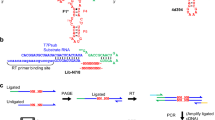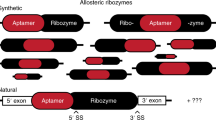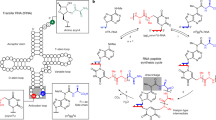Abstract
The RNA-world hypothesis proposes that, before the advent of DNA and protein, life was based on RNA, with RNA serving as both the repository of genetic information and the chief agent of catalytic function1. An argument against an RNA world is that the components of RNA lack the chemical diversity necessary to sustain life. Unlike proteins, which contain 20 different amino-acid subunits, nucleic acids are composed of only four subunits which have very similar chemical properties. Yet RNA is capable of a broad range of catalytic functions2,3,4,5,6,7. Here we show that even three nucleic-acid subunits are sufficient to provide a substantial increase in the catalytic rate. Starting from a molecule that contained roughly equal proportions of all four nucleosides, we used in vitro evolution to obtain an RNA ligase ribozyme that lacks cytidine. This ribozyme folds into a defined structure and has a catalytic rate that is about 105-fold faster than the uncatalysed rate of template-directed RNA ligation.
This is a preview of subscription content, access via your institution
Access options
Subscribe to this journal
Receive 51 print issues and online access
$199.00 per year
only $3.90 per issue
Buy this article
- Purchase on Springer Link
- Instant access to full article PDF
Prices may be subject to local taxes which are calculated during checkout



Similar content being viewed by others
References
Gesteland,R. F., Cech,T. R. & Atkins,J. F. (eds) The RNA World 2nd edn (Cold Spring Harbor Laboratory Press, Cold Spring Harbor, 1999).
Kruger,K. et al. Self-splicing RNA: autoexcision and autocyclization of the ribosomal RNA intervening sequence of Tetrahymena. Cell 31, 147–157 (1982).
Guerrier-Takada,C., Gardiner,K., Marsh,T., Pace,N. & Altman,S. The RNA moiety of ribonuclease P is the catalytic subunit of the enzyme. Cell 35, 849–857 (1983).
Lorsch,J. R. & Szostak,J. W. In vitro evolution of new ribozymes with polynucleotide kinase activity. Nature 371, 31–36 (1994).
Ekland,E. H. & Bartel,D. P. RNA-catalysed RNA polymerization using nucleoside triphosphates. Nature 382, 373–376 (1996).
Zhang,B. & Cech,T. R. Peptidyl-transferase ribozymes: trans reactions, structural characterization and ribosomal RNA-like features. Chem. Biol. 5, 539–553 (1998).
Unrau,P. J. & Bartel,D. P. RNA-catalysed nucleotide synthesis. Nature 395, 260–263 (1998).
Levy,M. & Miller,S. L. The stability of the RNA bases: implications for the origin of life. Proc. Natl Acad. Sci. USA 95, 7933–7938 (1998).
Bartel,D. P. & Szostak,J. W. Isolation of new ribozymes from a large pool of random sequences. Science 261, 1411–1418 (1993).
Ekland,E. H., Szostak,J. W. & Bartel,D. P. Structurally complex and highly active RNA ligases derived from random RNA sequences. Science 269, 364–370 (1995).
Wright,M. C. & Joyce,G. F. Continuous in vitro evolution of catalytic function. Science 276, 614–617 (1997).
Hayatsu,H., Wataya,Y. & Kai,K. The addition of sodium bisulfite to uracil and to cytosine. J. Am. Chem. Soc. 92, 724–726 (1970).
Rohatgi,R., Bartel,D. P. & Szostak,J. W. Kinetic and mechanistic analysis of nonenzymatic, template-directed oligoribonucleotide ligation. J. Am. Chem. Soc. 118, 3332–3339 (1996).
Yoshida,H., Kumimoto,H. & Okamoto,K. dutA RNA functions as an untranslatable RNA in the development of Dictyostelium discoideum. Nucleic Acids Res. 22, 41–46 (1994).
Shu,H., Wise,C. A., Clark-Walker,G. D. & Martin,N. C. A gene required for RNase P activity in Candida (Torulopsis) glabrata mitochondria codes for a 227-nucleotide RNA with homology to bacterial RNase P RNA. Mol. Cell. Biol. 11, 1662–1667 (1991).
Goodall,G. J. & Filipowicz,W. The A-U rich sequences present in the introns of plant nuclear pre-mRNAs are required for splicing. Cell 58, 473–483 (1989).
Crick,F. H. C. The origin of the genetic code. J. Mol. Biol. 38, 367–379 (1968).
Vassylyev,D. G. & Morikawa,K. Precluding uracil from DNA. Structure 4, 1381–1385 (1996).
Vartanian,J., Henry,M. & Wain-Hobson,S. Hypermutagenic PCR involving all four transitions and a sizeable portion of transversions. Nucleic Acids Res. 24, 2627–2631 (1996).
Cadwell,R. C. & Joyce,G. F. Randomization of genes by PCR mutagenesis. PCR Methods Applic. 2, 28–33 (1992).
Stern,S., Moazed,D. & Noller,H. F. Analysis of RNA structure using chemical and enzymatic probing monitored by primer extension. Methods Enzymol. 164, 481–489 (1988).
Acknowledgements
This work was supported by a grant from NASA.
Author information
Authors and Affiliations
Corresponding author
Rights and permissions
About this article
Cite this article
Rogers, J., Joyce, G. A ribozyme that lacks cytidine. Nature 402, 323–325 (1999). https://doi.org/10.1038/46335
Received:
Accepted:
Issue Date:
DOI: https://doi.org/10.1038/46335
This article is cited by
-
RNA ligase ribozymes with a small catalytic core
Scientific Reports (2023)
-
An RNA-cleaving threose nucleic acid enzyme capable of single point mutation discrimination
Nature Chemistry (2022)
-
Side chain determinants of biopolymer function during selection and replication
Nature Chemical Biology (2019)
-
Evolution of an Enzyme from a Noncatalytic Nucleic Acid Sequence
Scientific Reports (2015)
-
Darwinian evolution of an alternative genetic system provides support for TNA as an RNA progenitor
Nature Chemistry (2012)
Comments
By submitting a comment you agree to abide by our Terms and Community Guidelines. If you find something abusive or that does not comply with our terms or guidelines please flag it as inappropriate.



